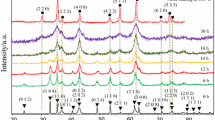Conclusions
Studies have been carried out to refine the grain composition of the original samples and the conditions under which the chemical phase analysis on synthetic electrosmelted mullite is made.
It is established that the mullite samples should be ground to a fraction finer than 88 μ in a mortar made from tungsten carbide or from an alloy which has a better microhardness. The dissolution of the sample should be determined in 10% HF at 18–23°C for 1 h.
Similar content being viewed by others
Literature cited
R. Rieke and W. Schade, Ber. Deutsch. Keram. Ges., No. 8, 427–442 (1930).
V. B. Kraft and T. A. Gurvich, Zavod. Lab., No. 8, 894–900 (1935).
L. D. Demidova and V. V. Goncharov, Ogneupory, No. 1, 23 (1951); No. 4, 181–182 (1955).
I. Lukacs and F. Simmler, Ber. Deutsch. Kera., Ges.,44, No. 9, 463–465.
E. N. Zedginidze, “Kinetics of the alumina-silica reaction in a mixture of oxides and natural materials in the 1050–1350°C interval,” Candidate's Dissertation, Moscow (1950).
Author information
Authors and Affiliations
Additional information
Translated from Ogneupory, No. 12, pp. 44–47, December, 1978.
Rights and permissions
About this article
Cite this article
Korobka, L.A., Shapovalov, V.S. & Ustichenko, V.A. Chemical phase analysis of electrosmelted mullite and refractory products based on it. Refractories 19, 779–782 (1978). https://doi.org/10.1007/BF01285720
Issue Date:
DOI: https://doi.org/10.1007/BF01285720




